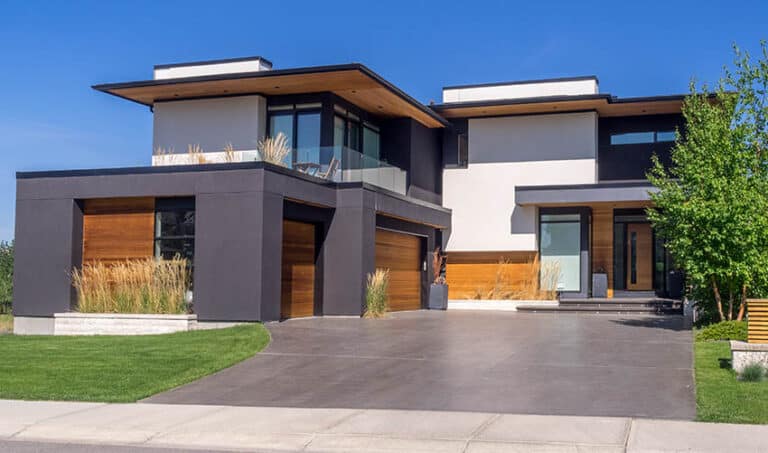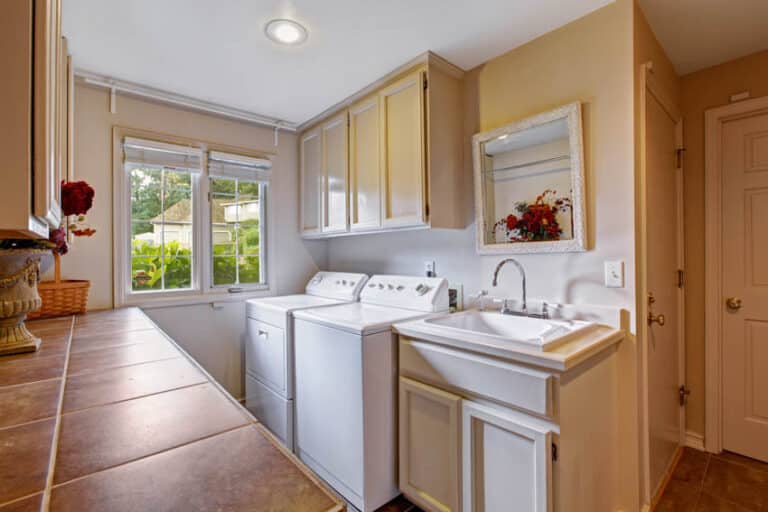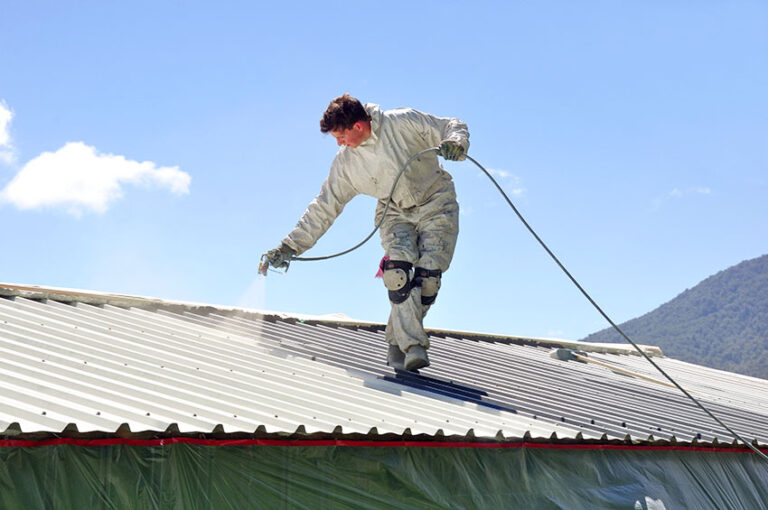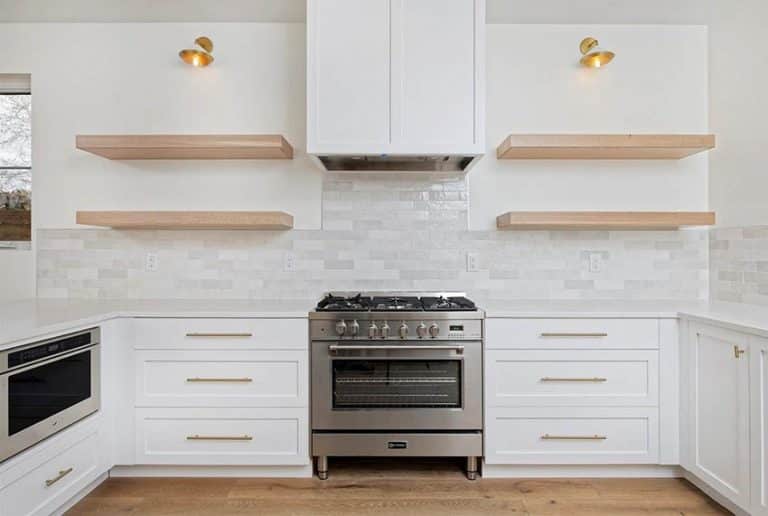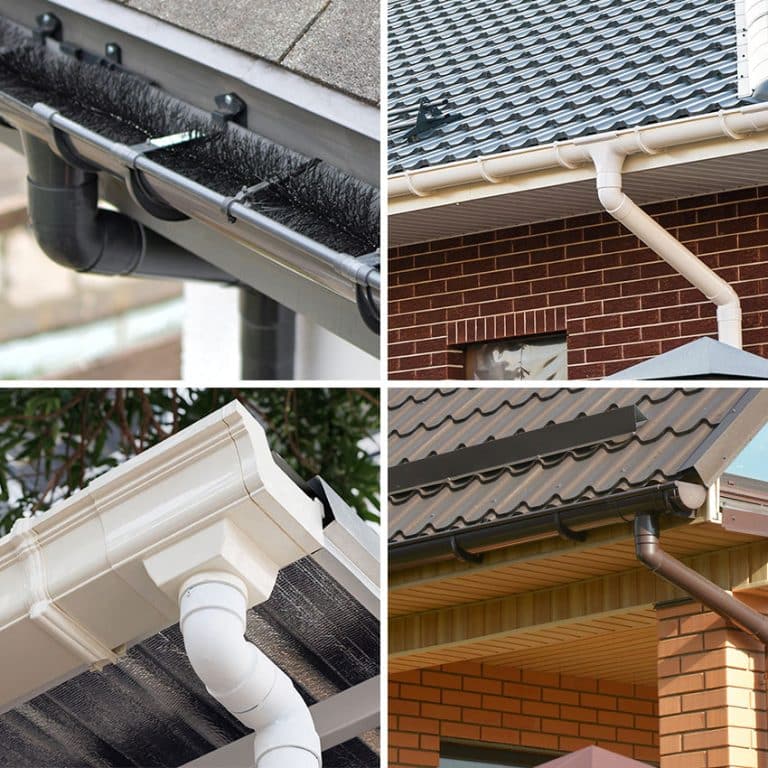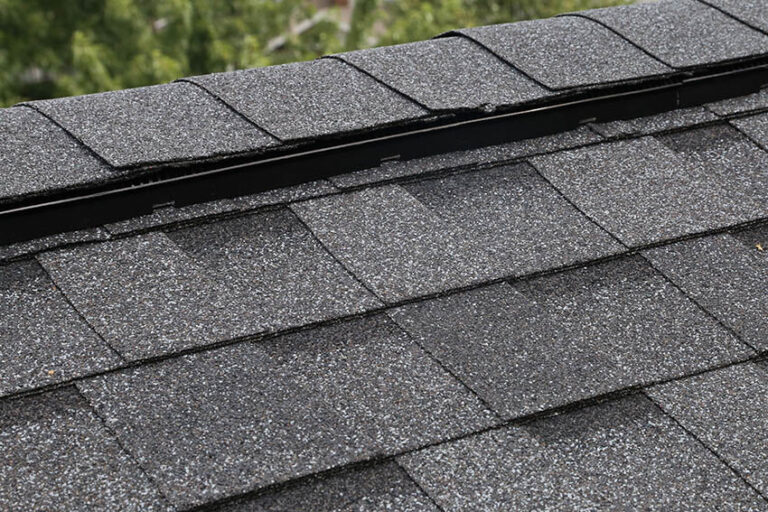Tips For Choosing A Brick Paver Driveway (Design Ideas)

When it comes to designing a driveway, options like different types of gravel and asphalt are common go-tos. However, if you want to give your driveway a unique look, you’ll want to consider adding brick pavers to your list of home renovations. This style has many benefits, from ensuring a custom, personalized appearance to more practical benefits that you can take advantage of. Keep reading, and we’ll teach you everything that you need to know about having a brick paver design outside of your home!
What Is a Paver Driveway?
As stated, there are plenty of great ways to design your driveway to ensure that it stands out and reflects your own personal style. That’s why it’s important to define exactly what your options are and why you might want specific materials, styles, and designs in your renovation. A paver driveway refers to the material laid down in a uniform or specific pattern. Pavers are also set in place as they’re laid out rather than allowed to set freely. This will give you a more even surface for your driveway compared to an option like gravel.
Pavers can be laid in a variety of patterns, and you can even use a variety of materials. As an example, homeowners can choose between options like concrete, cement, cobblestone, and, what this guide will focus on, brick pavers. Each choice has its distinct advantages and varies in style, cost, and maintenance. You can rely on this material to offer plenty of choices to find the perfect fit for you and your home.
What are the Best Paving Stones for a Driveway?
Naturally, with so many options in this market, you might wonder what the best choices are. Some paver materials are indeed more beneficial to a homeowner than others. So, here’s a quick breakdown of your top options. Overall, if you want the most out of your investment, it’s a good idea to go with options like brick, cobblestone, or concrete. This is true for a few different reasons.
For one, these are fairly economical options. By choosing one of these, you won’t have to worry quite as much about breaking the bank to renovate your home. On top of that, these are fairly long-lasting materials to rely on. This means that you won’t find yourself replacing or repairing them too soon after you lay them out. Remember, these pavers will last longer when properly cared for and preserved.
In addition to that, these materials are greatly varied, meaning that you can stay within these options but still have something that stands out from other stone designs thanks to the appearance of individual patterns as well as the greater layouts they’re used to make up. See more types of driveways here.
Paver Patterns for the Driveway
Here are the most popular patterns
| Pattern | Description | Aesthetic & Benefits |
|---|---|---|
| Herringbone | Interlocking V-shape | Strong visual, high stability for heavy traffic |
| Basketweave | Square grid, like a woven basket | Vintage look, low complexity, suits traditional styles |
| Running Bond | Bricks end-to-end in linear lines | Simple, elegant, widens narrow areas |
| European Fan | Fan-like radial layout | Sophisticated, classy, professional installation advised |
| Circular | Radiates from center in circles | Dynamic, unique, ideal for curved designs |
| Stack Bond | Grid-like, checkered pattern | Modern, orderly, best for lighter traffic |
There are nearly endless possibilities when it comes to driveway paver patterns. The design concerns the position in which the blocks are laid out. These are a few of the most popular options you have. One of the most commonly used options is a herringbone pattern. In this layout, individual pavers are set at a 45-degree angle from the end of the driveway or the beginning of your garage. This interlocking pattern is attractive and helps reduce how much the blocks shift.
Another option is the ashlar pattern. This pattern uses differently-sized pavers to create more gridded patterns, usually mixing up rectangles and squares of different sizes. This is also a great choice when it comes to highly trafficked areas. You can also use a classic like a basketweave or running bond pattern. This works well for residential driveways, but the pattern isn’t quite suited to high-traffic areas. That means it’s best to avoid this pattern in commercial driveways and heavy-use walkways.
Paver Designs Used for Driveways
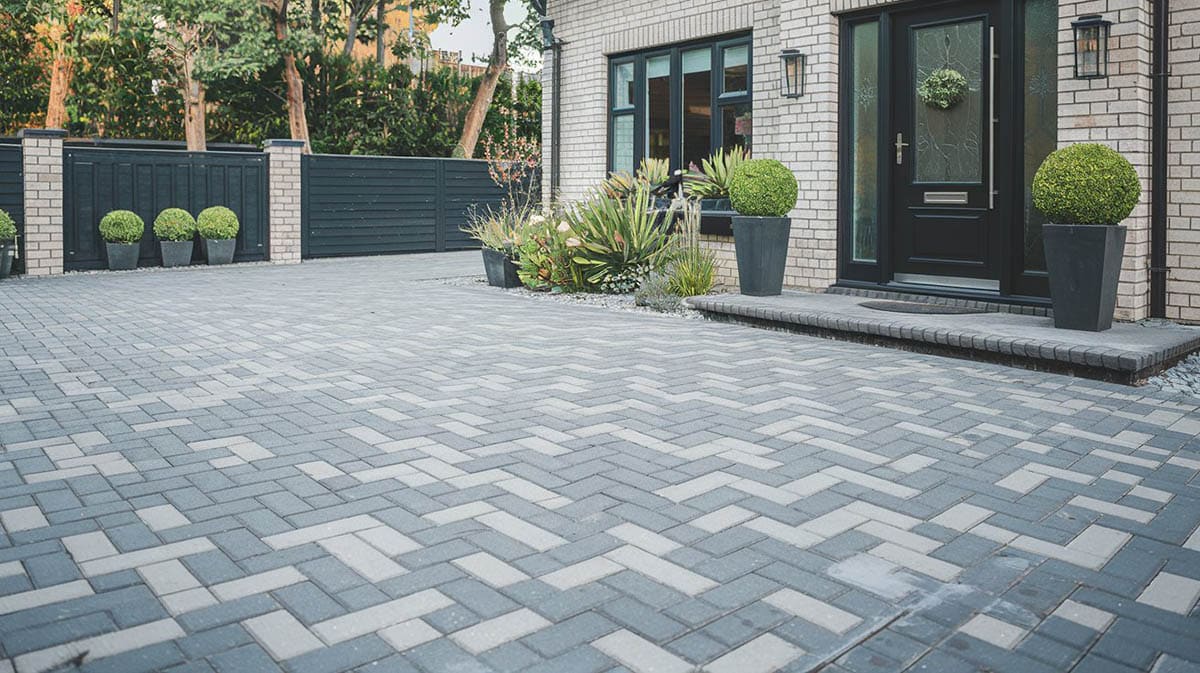
There are plenty of different ways that you can design your driveway pavers. As discussed above, you can vary factors such as your material choice and the patterns they’re laid out in. Yet, there’s more to driveway paver design options than just this. For one, you’ll want to consider your driveway itself. How long is it? How much foot and vehicle traffic does it need to withstand? What’s your favorite style that fits you’re existing decor and landscaping while also fulfilling your practical needs?
You can also consider mixing materials and styles to fit your wants and needs. For instance, a modern driveway may have a very different layout than a traditional design. We’ll take a look at some of these beneficial pairings to help you choose the option that works best for you not only in practice but also in appearance.
Paver with Concrete Driveway
One pairing that you can go with is a concrete and paver driveway. This can mean two different things, and both have advantages. For one, pavers themselves can be made out of concrete. These types are fairly popular for their longevity and affordability. Unfortunately, there are a few drawbacks to using concrete blocks, such as a higher level of fragility than other options. Using a brick-block driveway is a more durable long-term option.
You can also use concrete and brick pavers to make a paired pattern. This will add variety to your driveway design by offering multiple patterns and designs. The varying textures and appearances will help to create something unique and one of a kind. Yet, it could end up with additional maintenance measures to protect the concrete and brick blocks.
Paver and Grass Driveway
Most people opt to have a grass yard. This can mean that when you install a paver driveway, there is grass on either side. Yet, you can also use the presence of grass to your advantage when you’re designing your paver layout. When most homeowners use a tight-knit pattern for their stones, they typically don’t want to deal with grass growing up within the cracks. On the other hand, there is a way to incorporate grass into your design without it looking like a fault in the installation process.
Most intentional grass and paver designs rely on blocks spaced out to allow grass to grow between them amply instead of sparingly, like you might see on a city sidewalk. These patterns are also more eco-friendly than a tight-knit pattern since they are more porous.
Paver and Asphalt Driveway
Using asphalt and pavers concurrently can give your home a nice touch by blending two seemingly different styles. Unlike the grass and pavers choice, though, this isn’t focused on putting the secondary material between individual blocks.
Alternatively, asphalt and paver driveways usually use the material to frame and enhance the standard appearance of an asphalt driveway. This can solely include placing pavers on either side of the driveway, but it also often includes placing them at either end of the driveway. This helps to give the driveway a defined border and boost the even, measured appearance of the layout while helping you to stand out from other houses with asphalt material.
Paver and Bricks Driveway Cost
When considering any home renovation, one of the first things that any homeowner will look into is how much that renovation will cost. Of course, the importance of knowing the cost of a brick paver driveway is no different. Luckily, these driveways aren’t as costly as you might fear them to be.
You can expect a general paver driveway to cost between $10 and $50 per square foot. The higher quality and more highly sought-after material you choose, the more expensive it will be. More intricate designs also increase the price of the project.
On average, a paver driveway made specifically with brick costs about $10 to $30 per square foot. This puts the standard price range for a full project between $6,100 and $18,250. This price largely depends on how big your area is, but it also varies based on factors such as labor costs for installation and where you source your materials. In addition, extra perks such as a custom design, a challenging installation or heated driveway can drive up the price you’ll pay.
Is a Brick Driveway Cheaper Than Concrete?
Comparative pricing is also important when it comes to considering specific renovations. After all, you have plenty of options, and it’s important to know what will fit you’re home and budget the best! Generally speaking, concrete is slightly cheaper than a brick paver driveway. At the same time, the starting range for brick blocks begins at around $10 per square foot, and concrete costs, on average, about $7.50 per square foot to start.
However, that doesn’t necessarily mean brick tiles lose out against options like stamped concrete. For example, brick doesn’t tend to crack like concrete does. This means that you may have to pay more to repair the natural erosion of the concrete blocks. Brick may also crack, but you can reduce this by committing to the proper upkeep and maintenance.
Paver Maintenance for Drive Pathways
Brick paver driveways are beautiful, but if you want them to stay that way, you must ensure that you care for them. This is how you ensure that your driveway is lastingly beautiful and preserved.
One of the best measures is to start adopting healthy cleaning habits with your brick driveway. Some of the daily tasks of upkeep are as easy as sweeping debris off of it regularly, especially in times like autumn.
You should also periodically powerwash it to offer a deep clean. Do not use a sandblaster – this will damage the surface of the bricks and make them more susceptible to water damage in the future. You should also avoid using muriatic acid on your bricks as well. This will cause discoloration or give the bricks a mottled look.
How Long Do Driveways with Pavers Last?
Another factor in the cost of a project is how long that project will last. If you opt for something with a short lifespan, you’ll incur the costs of repairing or replacing it shortly down the road. If you’re trying to save money and time, it’s better to choose an option that will allow you to enjoy the beauty of your new renovation for years to come.
When it comes to driveways, you’re in luck because they’ll stick around for quite a while! For the most part, you can expect your pavers to look excellent for the next 30 to 50 years. However, this can depend on a few factors.
For one, the materials you get will play into their longevity. For instance, permeable pavers last closer to 20 to 25 years as a median, while a cobblestone design will easily stick around as long as 75 years. Brick paver driveways lean towards the upper range of the expected lifespan.
You’ll also have the chance to enjoy your hardscape for longer if you stay up-to-date on maintenance, as we’ve discussed and will continue to discuss. After all, anything will last longer if you treat it well than something that isn’t taken care of.
Paver Sealers for the Driveways
Another important maintenance step in caring for a brick block driveway is to seal it properly. This will help with various issues, such as repelling stains and extending the lifespan of your pavers. Most brick paver sealing is done by contractors who installed the project shortly after the initial job.
Regardless of when this process is done, the important first step to remember is that the brick needs to be cleaned first. You don’t want to trap any debris in with the brick, taking away from its aesthetic qualities and longevity.
If the proper sealant is used later to reseal a brick paver driveway, most contractors will also remove the old sealant layer. This is especially helpful in fixing uneven sealing, but it is generally better for the bricks and their lifespan overall.

